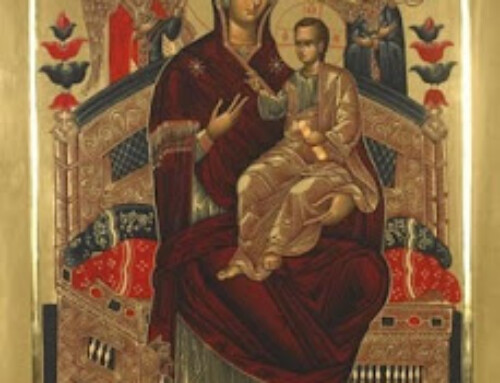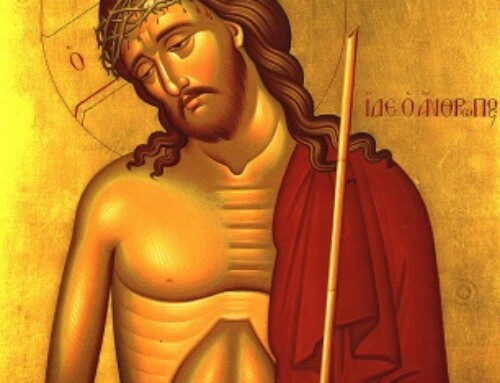Word Magazine June 1992 Page 12-13
CONTINUING PROJECTS FOR SUNDAY SCHOOLS
by Archpriest George Alberts
In most Orthodox churches, the church or Sunday school is just that — a group of children from the church who meet for one hour or less on Sunday and learn about the Church. Other than perhaps a program or two a year, they are involved only in a very limited way in the life of the church community in particular or the local community in general. Often on the religion page of our local newspapers we see articles about our church school groups but hardly ever do we read about Orthodox church schools doing something for their own church or their community. Others are involved in televised Bible Bowls, bicycle rides and walks to raise funds for the hungry or the sick, community service projects that help the poor, elderly or handicapped, etc. All too often we are content with just getting the children to come to church school and do their lessons! “How can we get them to do more,” we ask, “when we have a hard enough time just getting them here on Sunday mornings?’’
I admit it’s not easy, but the key to answering this question rests in the answer itself. We can get them there if we give them a reason or purpose to come; they must be allowed to feel that they are an important part of the Church by allowing them to become that important part. Rather than saying “you are too young to help;” “wait until you grow up:” “this is a job for grown-ups, moms and dads,” tell them, “we really need your help,” “this will be your responsibility OK;” “you are in charge of this project.” You would be surprised at how much can be done for the church and the community even by young children, if they are given a chance to help and feel that they are just as much an important part of the church as the Ladies Guild or SOYO.
What can be done? Here are just a few suggestions. I have divided them into church and community projects although some of them can be done for both. There are plenty more than these.
Check with your priest and parish council for ideas for your church school. Keep your eyes and ears open in your community for other projects. I’m sure that you can find many more than I have suggested by looking for what needs to be done.
CHURCH PROJECTS
Projects for the church can be divided into two different categories: 1) Serving church members and 2) Serving the church itself. The projects I have chosen are geared to the sick and shut-ins, helping them to realize that the church still cares for them. All too often the only contact with the church that these people have, (especially if they have no relatives in the congregation) is the Parish priest who visits them and takes Holy Communion to them. How often I have heard them lament that “after spending all my life working for the church, selling tickets, cooking for the dinners, helping at everything they had, no one even comes to see me or remembers what I did for them.” “They don’t even know if I’m dead or alive.” What better way to let them know that we care about them than to have our children, whom they may not even know, express our love and concern. This will help our children as well realize even from a young age that the church is not only those people we see each Sunday but those who are unable to attend as well. This will help them to understand the concept of the Church militant (here on earth) and the Church triumphant (those already in heaven) being members of the same church; when one dies or is separated from us, he is still a part of us in our thoughts, in our prayers, and in our love. They will also begin to understand the use of “memory eternal.’’ We don’t forget our Christian brothers and sisters whether they are separated from us by illness or by death.
Even the smallest child can help to make things for the shut-ins or the sick. They can decoupage icon prints onto wood so that the priest and/or a group of church school children themselves can take to them as an expression of faith and love. Plants can be grown from seed even by pre-schoolers who can learn about caring, growth, new life, and sharing with others by giving these plants with love. Plant holders also can be made from popsicle sticks, plastic bottle bottoms, etc.
Another project especially for the shut-ins is the making of cassette tapes of the Liturgy, sermons, or talks given at church. Sections from the Bible, Church Fathers, or other books can be read on tape and given to the blind or those who cannot read for themselves. The “tape ministry” is one that has been neglected in our Orthodox Churches.
Another project that is successful in many other churches is the adopt-a-grandparent project. Several church school children can choose a shut-in or elderly parishioner with no family and ‘‘adopt’’ him/her. This means visiting them regularly, talking with them, helping them, showing them that the church still cares about them. This can be done with “special need” parishioners as well. Both the “adopted” person and the child will gain from this experience.
One last project to help those parishioners who are unable to help themselves is home cleanup. Many people need help raking leaves in the fall or shoveling snow in the winter. Many of our children do these tasks for others in their neighborhood, why not for church members? Be sure to have someone in the parish make these arrangements and scheduling, keeping in mind that students should commit themselves to something they can actually achieve.
Other church projects revolve around the church community itself. They help to beautify the church or assist it in its work. The church school can help clean the church by doing that “little extra” to prepare for special Feast-days like Christmas, Easter and the Feastday of the parish. They can oil the iconostasis (if you have a wooden one), clean the candle holders, processional cross and fans, etc. During the cleaning session you can teach them about the use of these articles in the service. For many this will be the only chance to see and touch these items. The church school can be in charge of the decorations for Christmas. They can adorn the tree with handmade decorations and ornaments. (Any good crafts book will demonstrate making Christmas decorations.) They can also plant trees, flowers or shrubs around the church to beautify it. Let them even pull the weeds as they grow and don’t pass up the opportunity to teach them about Christ’s parable of the sower and the weeds that choked the plants. Many teachings of Christ are taken from and related to nature. Make use of them.
Another special subject is the making of banners. This is also a “lost art” in most of our churches. The church school can work as a whole or in groups to fashion a banner for a feastday or for decoration and inspiration. Great lessons in iconography and the main figures of church feasts can be taught along with Bible verses in banner making. Any act of “creation” can lead to a better understanding of God’s own creative power and love in creating mankind. Why not allow the children to meet on a Saturday and make the Holy Bread for Sunday? Here again a great deal can be learned and related to the teachings of our Lord. If we want our children to continue the practice of offering Holy Oblation for the health of and/or memory of their loved ones, we must begin to teach them that from an early age. Our children can play a part in the Liturgical life of the church especially during Lent.
They can decorate candles for Palm Sunday and help with the decoration of the bier on Good Friday. Let the older children help in reading the Hours of Good Friday or keeping a vigil on Good Friday afternoon or evening. Have them make icons in church school to carry at the Triumph of Orthodoxy Sunday procession. Let them strip the palms on Lazarus Saturday and decorate the church for Palm Sunday. How many of our churches have bulletin boards that are empty or cluttered with old announcements or articles that never seem to be taken down? Give the church school the bulletin board(s) as their project. Assign each class a month. They can decorate it to reflect the feastdays or take a theme each month and illustrate it. Most Christian bookstores have books to help with ideas or patterns for bulletin boards. The last project I am mentioning can be done by the church school for its own benefit and use. It is the making of filmstrips, slide presentations, tapes, or videotapes, illustrating the Liturgy, sacraments, Bible stories, etc. The students learn by doing and the research involved in the making of these presentations. After they are made, they can be used over and over again as teaching tools for other classes. (For detailed instruction in how to use Videofilm, purchase a copy of Creative Activities I from Department of Christan Education, 358 Mountain Road, Englewood. NJ. 07631.)
As I mentioned before these are just a few suggested projects. I’m sure you can use these as a springboard to coming up with your own projects or tailor them to fit your own particular needs.
COMMUNITY PROJECTS
Community projects are very important. They help the church school children realize that we are not entities in ourselves, but we must love our neighbors as ourselves and are part of the community around us. The church school can help. Here are some ideas. The Special Olympics is a project of our Teen SOYO both regionally and nationally. We have been involved with this project for several years. It is a very important program as well as being very gratifying and educational. In working with these children our own children can learn what love and caring is all about. Check with the Special Olympics committee in your town to see in what ways your church school children can help.
There are many other suffering people in the world. Projects by our church school children can help them as well. Carnivals for MS, fund raisers for ALSAC and other charitable organizations can be sponsored by our church school. They can participate in local hunger walks and bike-a-thons. They can sponsor or co-sponsor with SOYO a Christmas party for needy and underprivileged children. Even the young children can make cookies, bring games to play or help decorate for the party. They can bring old toys for TOYS-FOR-TOTS, or prepare treats, Christmas, Easter, and Thanksgiving food or fruit baskets to distribute to nursing homes, pediatric wards of local hospitals, and, with the permission of the hospital or nursing home, go caroling to the patients and distribute what they brought. These are just a few ideas to get started with. Contact your local social service agency to find out more ways to help and what can and cannot be done.
The above is by no means an exhaustive list of church school projects. They are only a few suggestions to get you started in your church and community. These are on-going projects that can be done from year to year and tailored to fit the needs of your local parish or community. The important thing to remember is to allow the children to have fun doing them — don’t make them into a chore or stifle their enthusiasm. Let them do it their way. No one likes doing things that he is forced to do. Allow time for fun and fellowship in all that you do.
Don’t try to cram things into the one hour Sunday morning time slot. Pick a few Saturdays throughout the year, perhaps when memorial Liturgies are celebrated. Have brunch for the children and then do your craft or service projects. If there is a camp nearby, you may want to rent it for a weekend. Leave after school on Friday, have your church school teachers come up and give the children their ‘‘Sunday’’ lessons, and spend the rest of the day on Saturday working on one or more special projects such as banners, icons, etc. You would be surprised what a change in atmosphere can do for creativity. Plan to have Vespers, confessions, and a campfire, if weather permits. You can leave in time to attend Liturgy in your own church on Sunday or if it can be arranged, have Liturgy at the camp. Do everything possible to make your projects enjoyable and gratifying experiences. Perhaps the most important thing of all is the fact that your children will grow up feeling that they are an important and integral part of your church and the community. What you will realize is that, in fact, they are!
Father George is pastor of St. Michael Church in Monessen, PA. And St. Ellien Church in Brownsville, PA. He is serving as the 1992 Camp Director at Antiochian Village.




